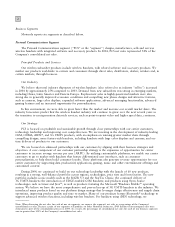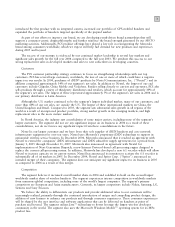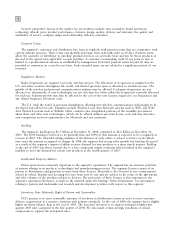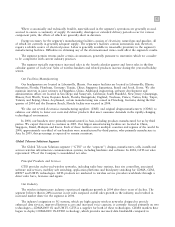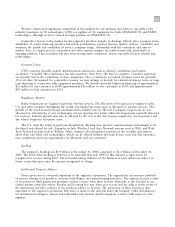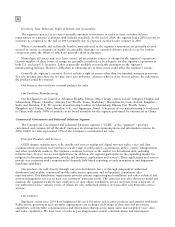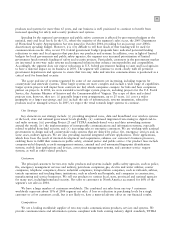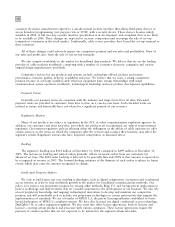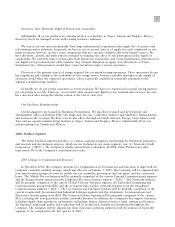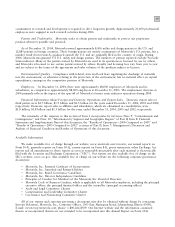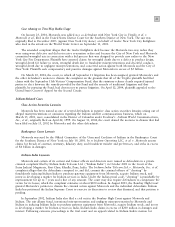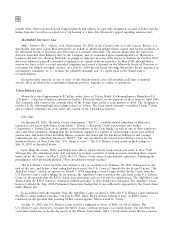Motorola 2004 Annual Report Download - page 20
Download and view the complete annual report
Please find page 20 of the 2004 Motorola annual report below. You can navigate through the pages in the report by either clicking on the pages listed below, or by using the keyword search tool below to find specific information within the annual report.
12
telematics control units, integrated wireless handsets, navigation and driver safety products and systems controls for
automotive vehicles.
The Energy Systems Group (""ESG'') delivers complete portable energy storage products and systems for many
of today's leading brand-name wireless handsets, handheld computers and other portable electronic products. A
signiÑcant portion of ESG's sales are to other businesses within Motorola, including the wireless handset business,
PCS, and the public safety and enterprise communications business, CGISS.
The Embedded Communications Computing Group (""ECCG''), formerly known as the Motorola Computer
Group (""MCG''), specializes in standards-based, embedded computing systems that are integrated by OEMs into a
wide variety of products in the telecommunications, industrial automation, defense, medical and aerospace
industries. In August 2004, the Company acquired Force Computers, a worldwide designer and supplier of open,
standards-based and custom embedded computing solutions. Force Computers was integrated with MCG, and the
two combined entities were renamed the Embedded Communications Computing Group.
The segment markets its products through a direct sales force, channel distributors and strategic distribution
partners.
Our Industry
The segment participates in three industries. We provide: (i) products and systems used in automotive vehicles,
(ii) portable energy systems, such as batteries used in wireless devices, and (iii) embedded computing systems.
Demand for our products is linked to various factors, including consumer demand for cars and wireless devices and
industrial demand for embedded computing systems.
In 2004, net sales were up for ACES due to new electronic controls and telematics products. ESG net sales
increased primarily due to increased shipments of wireless handset devices by PCS. ECCG net sales increased due to
the Force Computers acquisition and increased demand for commercial, oÅ-the-shelf embedded computing systems.
Our Strategy
The strategy of the businesses that make up the segment is to accelerate growth by increasing share in existing
markets and by expanding into related market segments. ACES continues to grow as automotive OEMs expand the
electronic content in their vehicle's powertrain, chassis, sensor, interior electronics and telematics systems. Going
forward, the growth in the global automotive electronics market is expected to outpace the growth rate of global
vehicle production. ACES is well positioned to take advantage of this growth.
We expect ECCG to grow by leading the move to higher utilization of standards-based embedded computing
systems. Growth also is expected as a result of the acquisition of Force Computers, which we expect to enable
ECCG to provide solutions for a wider range of customer applications needs, supported by a broader portfolio of
boards, systems and services. These products enable OEMs in telecommunications, industrial automation, defense
and aerospace industries to acquire commercial, oÅ-the-shelf computing systems instead of creating these systems
with in-house engineering resources. This change enables OEMs to provide more cost-eÅective computing systems
and to focus their own research and development on applications that add value to and diÅerentiate the computing
system.
ESG's growth is tied to the volume of portable devices in the mobile computing and portable communications
markets.
Customers
In 2004, 60% of the segment's net sales were to four customers: 19% to Motorola, 17% to General Motors,
12% to Ford and 12% to Daimler Chrysler. Our largest customer within Motorola is the wireless handset business,
PCS. The loss of a signiÑcant portion of any of these customers' business could have a material adverse eÅect upon
the segment.


